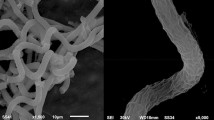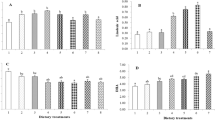Abstract
The biomass of the red alga Porphyridium sp.constitutes a unique combination of soluble sulfatedpolysaccharide that accounts for about 70% of thealgal dry weight, and various polyunsaturatedfatty acids (PUFA) such as arachidonic andeicosapentaenoic acid (AA, 20:4 ω6 and EPA,20:5 ω3). In view of earlier results in ourlaboratory showing a reduction in serum cholesteroland triglyceride levels in rodents fed with red algalbiomass, we set out to examine the influence of algalbiomass as a feed additive on the metabolism ofchickens, with an emphasis on blood and eggcholesterol levels. For that purpose, lyophilizedalgal biomass was fed to 12–13, 30-week-old, WhiteLeghorn chickens for 10 days at a proportion of 5% or10% of the standard chicken diet. Twelve chickensfed with unsupplemented diet served as the control. No differences in body weight, egg number, and eggweight were found between the algal-fed chickens (atboth concentrations) and the control. However,chickens fed with algal biomass consumed 10% lessfood for both groups, and their serum cholesterollevels were significantly lower (by 11% and 28% forthe groups fed with 5% and 10% supplement,respectively) as compared with the respective valuesof the control group. Egg yolk of chickens fed withalgae tended to have reduced cholesterol levels (by10%) and increased linoleic acid and arachidonic acidlevels (by 29% and 24%, respectively). In addition,the color of the egg yolk was darker as a result ofthe higher carotenoid levels (2.4 fold higher) forchickens that fed with 5% supplement. Theseresults encourage the development of an improvedchicken feed having dietary fibers and polyunsaturatedfatty acids.
Similar content being viewed by others
References
Ahern TJ, Katoh S, Sada E (1983) Arachidonic acid production by the red alga Porphyridium cruentum. Biotech. Bioengng 25: 1057-1070.
Arad (Malis) S (1988) Production of polysaccharides from red unicellular algae. In Stadler T, Mollion J, Verdus MC, Karamanos Y, Morvan H, Chistiaen D (eds), Algae Biotechnology. Applied Science Publishers, London, 65-87.
Beyer RS, Jensen LS (1993) Reduced plasma cholesterol and lipoprotein in laying hens without concomitant reduction of egg cholesterol in response to dietary sorbose. Poultry Sci. 72: 88-97.
Bligh EG, Dyer WJ (1959) A rapid method of total lipid extraction and purification. Can. J. Biochem. Physiol. 37: 911-917. Cohen E, Arad (Malis) S (1989) A closed system for outdoor cultivation of Porphyridium. Biomass 18: 59-67. Cohen Z, Norman H, Heimer YM (1995) Microalgae as a source of n-3 fatty acids. World Rev. Nutr. Diet. Basel, Karger 77: 1-31. Connor SL, Connor WE (1997) Are fish oils beneficial in the prevention and treatment of coronary artery disease? Am. J. Clin. Nutr. 66: 1020S-1031S. Dubois M, Gilles KA, Hamilton JK, Rebers PA, Smith F (1956) Colorimetric method for determination of sugar and related substances. Anal. Chem. 28: 350-356. Dvir I, Chayoth R, Sod-Moriah U, Nyska A, Stark AH, Madar Z, Arad (Malis) S (2000) Soluble polysaccharides and cells of red microalga Porphyridium sp. reduce serum cholesterol and alter intestinal morphology in rats. Br. J. Nutr. (in press). Edington JD, Geekie M, Carter R, Benfield L, Ball M, Mann J (1989) Serum lipid response to dietary cholesterol in subjects fed a low-fat, high-fiber diet. Am. J. Clin. Nutr. 50: 58-62. Elkin RG, Rogler JC (1990) Reduction of the cholesterol content of eggs by the oral administration of lovastatin to laying hens. J. agric Food. Chem. 38: 1635-1641. Gordon DJ, Rifkind BM (1989) High-density lipoprotein-The clinical implications of recent studies. N. Engl. J. Med. 321: 1311-1316. Griffin HD (1992) Manipulation of egg yolk cholesterol: a physiologist's view. W. Poultry Sci. J. 48: 101-112. Hargis PT (1988) Modifying egg yolk cholesterol in the domestic fowl-a review. W. Poultry Sci. J. 44: 17-29. Hargis PT, Van-Elswyk ME (1993) Manipulating the fatty acid composition of poultry meat and eggs for the health conscious consumer. W. Poultry Sci. J. 49: 251-264. Harris WS (1989) Fish oils and plasma lipid and lipoprotein metabolism in humans: a critical review. J. Lipid. Res. 30: 785-807. Ito K, Hori K (1989) Seaweed: chemical composition and potential food uses. Food Rev. Int. 5: 101-144. Kates M (1986) Techniques of lipidology. In Burdon RH, Van-Knippenberg PH (eds), Laboratory Techniques in Biochemistry and Molecular Biology. Elsevier, New York, 104-105. Kishimoto Y, Wakabayashi S, Takeda H (1995). Hypocholesterolemic effect of dietary fiber: relation to intestinal fermentation and bile acid excretion. J. Nutr. Sci. Vitaminol. 41: 151-161. Leskanich CO, Noble RC (1997) Manipulation of the n ? 3 polyunsaturated fatty acid composition of avian eggs and meat. W. Poultry Sci. J. 53: 155-183. Lirette A, Robinson AR, Crober DC, Lawson PD, Firth NL (1993) Effect of oat bran, cotton seed hulls and guar gum on chicken egg and blood lipids during the early laying period. Can. J. Anim. Sci. 73: 673-677. Lowry OH, Rosebrough NT, Farr AL, Randall RJ (1951) Protein measurement with the folin phenol reagent. J. biol. Chem. 193: 265-275. Oh SY, Ryue J, Hsieh CH, Bell E (1991) Eggs enriched in ? ? 3 fatty acids and alterations in lipid concentration in plasma and lipoproteins and in blood pressure. Am. Soc. Clin. Nutr. 54: 689-695. Pigott GM, Tucker BW (1987) Science opens new horizons for marine lipids in human nutrition. Food Rev. Internat. 3: 105-138. Rise M, Cohen E, Vishkautsan M, Cojocaru M, Gottlieb HE, Arad (Malis) S (1994) Accumulation of secondary carotenoids in Chlorella zoffiugieusis. J. Plant. Physiol. 144: 287-292. Searcy RL, Bergquist LM (1960) A new color reaction for the quantitation of serum cholesterol. Clin. Chim. Acta. 5: 192-199. Spiller RC (1996) Cholesterol, fiber, and bile acids. Lancet 347: 415-416. Van-Elswyk ME (1997a) Comparison of ? ? 3 fatty acid sources in laying hen rations for improvement of whole egg nutritional quality: A review. Br. J. Nutr. 78: S61-S69. Van-Elswyk ME (1997b) Nutritional and physiological effects of flax seed in diets for laying fowl. W. Poultry Sci. J. 53: 253-264.
Author information
Authors and Affiliations
Rights and permissions
About this article
Cite this article
Ginzberg, A., Cohen, M., Sod-Moriah, U.A. et al. Chickens fed with biomass of the red microalga Porphyridium sp. have reduced blood cholesterol level and modified fatty acid composition in egg yolk. Journal of Applied Phycology 12, 325–330 (2000). https://doi.org/10.1023/A:1008102622276
Issue Date:
DOI: https://doi.org/10.1023/A:1008102622276




